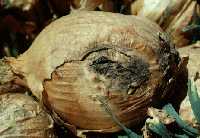Botrytis blight
Scientific name:
Botrytis spp.
Causal organism: Fungus
Common name: Gray mold disease, Botrytis bulb rot, Botrytis rot
Host plants
Onion and other alliums, beans, carrot, celery, citrus, crucifers, cucurbits, eggplant, pepper, potato, tomato, and a wide range of herbaceous and woody plants
Affected plant stages
All the plant's growth stages
Affected plant parts
All plant parts
Symptoms
 Photo Source: Colorado State University
Photo Source: Colorado State University
Botrytis disease commonly appears as blossom blights and fruit rots. The fungus can cause other diseases like;
damping-off, stem cankers and rots, leaf spots, and tuber/corm/bulb/root rots. It causes gray mold rot on bean, cabbage carrot, eggplant, etc.; tip end rot on tomato, pepper, squash, banana, citrus, etc.; and gray mold on many fruits and vegetables.
Gray mold appears as tan or brown watersoaked lesion that becomes grayish or dried-out on fruits. The presence of numerous silver-gray to gray-brown spores of the fungus is very evident on the infected plant parts. Tiny, black, and shiny fruiting bodies might also be seen embedded in the diseased plant tissues.
On onion and garlic, infection appears during storage but it started already in the field. Plants are stunted with dead and dying outer leaves. Affected tissues are watersoaked which later become dry with dead tissues. At storage, the symptom begins at the neck, wherein the infected tissues soften and become watersoaked that leads to decay.
Infected leaves have watersoaked spots that become brown
and/or dry. On infected flowers, the disease produces a gray or brown fluffy growth. The infection then spreads to the flower stalk that causes the flower to droop. The infected parts turn brown and dry. The infected fruits are covered with fine gray or tan mold. When disturbed, the mold sends up large dusts-like clouds of spores.
Botrytis rot infects citrus and is mainly a problem of lemon fruit. The fungi enter through the injured tissues and form velvety mats of fruiting bodies that cause the fruit's surface to be bumpy. Infected twigs and small branches die back several inches.
Conditions that favor development
- Cool temperature and high humidity
- Drizzle or light rain that lasts for several days
- Plants that are heavily fertilized with nitrogen
- Poor air circulation among the plants
- Poor sanitation and poor plant management
Preventive control
- Practice proper plant spacing, between the row and the hill, to promote rapid drying of plants and to ensure good air circulation. If a plant is congested with leafy growth, prune away some of the growth (especially in the centre of the plant) to allow air movement.
- Remove the faded or blighted flowers, blighted leaves, or the entire plant that is infected at the base. Put the diseased parts in a pail and bury (into a hole of about 1 foot deep and cover them with same amount of soil) or burn them. However, do not practice any sanitation when plants are wet with dew or rain since this could spread the fungal spores.
- Cut or pull off infected dead plants away from the field to remove the source of disease for the next crops.
- Avoid over-watering and/or misting the plants.
- Spray plant with Compost tea or Bordeaux mixture.
- Plow-under all the plant debris after harvest.
- There should be proper flow of air in the storage room to prevent the fungus to further develop.

